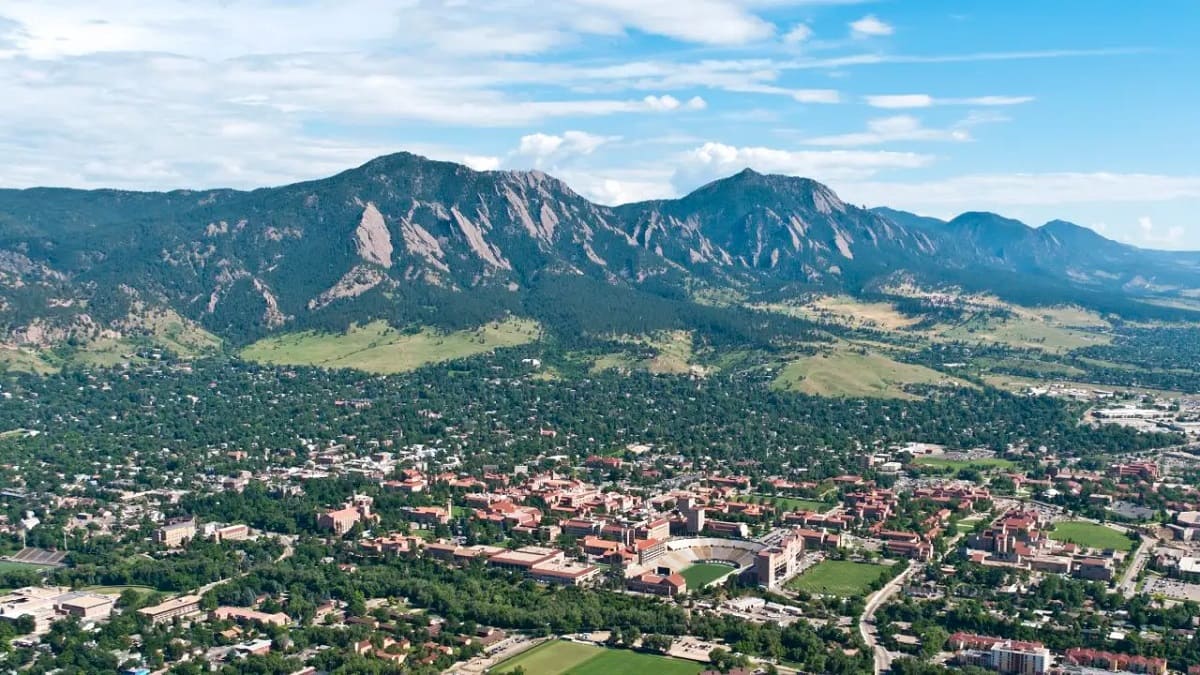Home>Weather and Climate>Austin Weather: A Comprehensive Guide To Year-Round Climate In Austin


Weather and Climate
Austin Weather: A Comprehensive Guide To Year-Round Climate In Austin
Published: March 1, 2024
Discover the year-round weather and climate in Austin with our comprehensive guide. Plan your activities with confidence using our detailed insights.
(Many of the links in this article redirect to a specific reviewed product. Your purchase of these products through affiliate links helps to generate commission for Temperatures.com, at no extra cost. Learn more)
Table of Contents
Introduction
Welcome to the vibrant city of Austin, Texas, where the weather is as diverse and dynamic as the culture. Nestled in the heart of the Lone Star State, Austin boasts a unique climate that showcases the best of all four seasons. From the balmy days of summer to the occasional winter chill, Austin's weather offers a rich tapestry of experiences for residents and visitors alike.
In this comprehensive guide, we will delve into the year-round climate of Austin, providing valuable insights into the distinct characteristics of each season. Whether you're planning a trip to the Live Music Capital of the World or considering a move to this bustling metropolis, understanding Austin's weather patterns is essential for making the most of your experience.
Throughout this guide, we will explore the nuances of spring, summer, fall, and winter in Austin, shedding light on the temperature fluctuations, precipitation levels, and unique weather events that define each season. Additionally, we will touch on extreme weather occurrences and highlight the best times to visit Austin for those seeking an optimal blend of favorable weather and exciting activities.
So, grab your sunscreen and umbrella as we embark on a journey through the ever-changing skies of Austin. Whether you're a weather enthusiast, a prospective resident, or a curious traveler, this guide is your passport to unlocking the secrets of Austin's captivating climate. Let's dive in and discover the fascinating world of Austin weather together.
Understanding Austin's Climate
Austin's climate is characterized by its diversity and variability, offering a blend of subtropical and semi-arid influences that shape the city's weather patterns throughout the year. Situated in the heart of Texas, Austin experiences distinct seasonal changes, each contributing to the city's unique charm and appeal.
The city's location in the southern part of the United States exposes it to a range of weather phenomena, from scorching summer days to occasional winter freezes. The subtropical climate brings hot, humid summers and mild winters, while the semi-arid influence contributes to lower precipitation levels and occasional drought conditions.
During the summer months, Austin basks in the warmth of the sun, with average temperatures ranging from the mid-80s to the mid-90s Fahrenheit. The combination of heat and humidity creates a sultry atmosphere, punctuated by occasional thunderstorms that provide relief from the sweltering conditions. These summer storms, often accompanied by spectacular lightning displays, contribute to the city's dynamic weather landscape.
As autumn arrives, Austin undergoes a gradual transition, with temperatures beginning to mellow and the humidity levels subsiding. Fall brings a welcome respite from the summer heat, allowing residents and visitors to enjoy outdoor activities amidst the backdrop of changing foliage. The city's parks and green spaces come alive with vibrant hues, offering a picturesque setting for leisurely strolls and outdoor gatherings.
Winter in Austin is a relatively mild affair, characterized by cool temperatures and occasional cold fronts that sweep through the region. While snow is a rare occurrence, the city may experience light flurries on rare occasions, adding a touch of magic to the winter landscape. The average winter temperatures range from the 40s to the 60s Fahrenheit, making it a comfortable season for exploring the city's cultural offerings and outdoor attractions.
Spring heralds the arrival of blooming wildflowers and pleasant temperatures, marking the beginning of outdoor festivals and events that celebrate the city's lively spirit. The weather during this season is characterized by mild, sunny days and cool evenings, providing an ideal backdrop for exploring Austin's eclectic neighborhoods and scenic outdoor spaces.
In summary, Austin's climate is a captivating fusion of subtropical warmth and semi-arid dryness, offering a diverse array of weather experiences throughout the year. Understanding the nuances of each season is essential for fully appreciating the city's dynamic climate and making the most of all that Austin has to offer.
Spring Weather in Austin
Spring in Austin ushers in a delightful transition from the cooler winter months to the warmth of impending summer. The season typically spans from March through May, offering a pleasant blend of mild temperatures, blooming flora, and a vibrant atmosphere that permeates the city.
As the grip of winter loosens its hold, Austin experiences a gradual rise in temperatures, with average highs ranging from the 70s to the 80s Fahrenheit. The city's parks and green spaces come alive with a kaleidoscope of wildflowers, including the iconic bluebonnets, creating a picturesque backdrop for outdoor activities and leisurely strolls. The gentle warmth of the sun, coupled with the refreshing coolness of spring evenings, sets the stage for a myriad of events and festivals that celebrate the city's cultural diversity and artistic flair.
Springtime in Austin also brings a sense of renewal and energy, reflected in the bustling outdoor markets, live music performances, and al fresco dining experiences that dot the city's landscape. The pleasant weather encourages residents and visitors to explore the city's eclectic neighborhoods, vibrant street art, and scenic outdoor trails, fostering a sense of connection with nature and community.
While spring showers are not uncommon, they contribute to the lush greenery and vibrant blooms that define the season. The occasional rain showers, often accompanied by fleeting thunderstorms, add a dramatic flair to the Austin skyline, creating a captivating backdrop for outdoor enthusiasts and photography enthusiasts alike.
Overall, spring in Austin offers an idyllic blend of mild temperatures, blossoming landscapes, and a lively ambiance that beckons residents and visitors to embrace the outdoors. Whether it's attending a music festival, picnicking in a park adorned with wildflowers, or simply savoring a leisurely stroll along the city's vibrant streets, springtime in Austin is a season of renewal and celebration, inviting everyone to revel in the city's natural beauty and cultural vibrancy.
Summer Weather in Austin
Summer in Austin arrives with a flourish, bringing with it the full force of the city's subtropical climate. Spanning from June through August, the summer season in Austin is characterized by long, sun-drenched days, balmy evenings, and the occasional dramatic thunderstorm that punctuates the sultry atmosphere.
The summer months usher in a wave of heat and humidity, with average temperatures soaring into the mid-80s to mid-90s Fahrenheit. The sun casts its golden glow over the city, infusing the landscape with a vibrant energy that permeates every corner of Austin. The warm embrace of summer beckons residents and visitors alike to seek refuge in the city's numerous waterways, from the iconic Barton Springs Pool to the tranquil shores of Lady Bird Lake, offering a refreshing respite from the sweltering heat.
While the summer heat can be intense, it also sets the stage for a myriad of outdoor activities and cultural events that define Austin's lively spirit. From open-air concerts and music festivals to bustling food markets and outdoor film screenings, the city comes alive with a palpable sense of excitement and creativity. The warm summer nights provide the perfect backdrop for al fresco dining experiences, rooftop gatherings, and leisurely strolls along the illuminated streets, creating an enchanting ambiance that captivates the senses.
In addition to the sun-drenched days, summer in Austin is also known for its spectacular thunderstorms that roll in with dramatic flair. These awe-inspiring displays of nature's power bring relief from the heat, offering a mesmerizing spectacle of lightning and thunder that illuminates the evening sky. The refreshing downpours that accompany these storms breathe new life into the city, rejuvenating the landscape and invigorating the spirit of Austin's residents.
While the summer heat and humidity can be intense, they also contribute to the city's dynamic and vibrant atmosphere, fostering a sense of community and creativity that defines Austin's cultural identity. Whether it's savoring a cool treat from a local ice cream parlor, embarking on a scenic hike along the verdant trails, or simply basking in the warm glow of a summer sunset, Austin's summer weather invites everyone to embrace the season's warmth and revel in the city's spirited charm.
Fall Weather in Austin
As the vibrant hues of autumn begin to paint the landscape, Austin undergoes a captivating transformation, ushering in a season of mild temperatures, changing foliage, and a palpable sense of anticipation. Spanning from September through November, fall in Austin offers a welcome respite from the summer heat, creating an idyllic backdrop for outdoor adventures and cultural experiences.
The arrival of fall brings a gradual cooling of temperatures, with average highs ranging from the 70s to the 80s Fahrenheit. The city's parks and green spaces become adorned with a tapestry of rich, earthy tones as the foliage transitions from lush greens to warm shades of red, orange, and gold. This natural spectacle sets the stage for leisurely strolls, outdoor picnics, and scenic drives through the picturesque Hill Country, offering residents and visitors a front-row seat to nature's breathtaking display.
The mild and pleasant weather of fall in Austin provides an ideal setting for a myriad of outdoor activities, from hiking along the city's scenic trails to partaking in al fresco dining experiences amidst the backdrop of autumnal splendor. The city's vibrant cultural scene comes alive with a host of fall festivals, art exhibitions, and live performances, offering a wealth of opportunities to immerse oneself in the creative pulse of Austin.
While fall in Austin is generally characterized by clear skies and comfortable temperatures, occasional rain showers contribute to the rejuvenation of the landscape, adding a touch of freshness to the air and enhancing the natural beauty of the city. The gentle patter of raindrops against the backdrop of fall foliage creates a serene and tranquil atmosphere, inviting residents and visitors to savor the simple pleasures of the season.
Overall, fall in Austin is a season of transition and celebration, offering a harmonious blend of natural beauty, cultural vibrancy, and outdoor allure. Whether it's embarking on a scenic hike, attending a fall festival, or simply savoring a pumpkin-spiced treat at a local café, the weather in Austin during the fall season sets the stage for memorable experiences and a deep appreciation of the city's dynamic charm.
Winter Weather in Austin
Winter in Austin brings a welcome shift in the city's climate, offering a reprieve from the warmth of the previous seasons and introducing a touch of seasonal charm to the landscape. Spanning from December through February, the winter season in Austin is characterized by mild temperatures, occasional cold fronts, and the rare possibility of light snowfall, creating a unique and captivating atmosphere.
The average winter temperatures in Austin range from the 40s to the 60s Fahrenheit, providing a comfortable and inviting setting for residents and visitors to explore the city's cultural offerings and outdoor attractions. While snow is a rare occurrence, the city may experience light flurries on rare occasions, adding a touch of magic to the winter landscape and infusing the city with a sense of wonder and delight.
The winter months also bring a sense of coziness and warmth to Austin, as residents and visitors embrace the season by partaking in seasonal festivities, savoring hot beverages at local cafes, and reveling in the city's cultural offerings. The city's vibrant music scene continues to thrive during the winter months, with live performances and intimate concerts providing a soulful soundtrack to the season.
Occasional cold fronts may sweep through the region, bringing brisk winds and cooler temperatures that offer a refreshing contrast to the warmth of indoor gatherings and festive celebrations. The city's parks and outdoor spaces take on a serene and tranquil ambiance, inviting individuals to embark on leisurely walks, engage in outdoor yoga sessions, or simply bask in the peacefulness of the winter landscape.
While winter in Austin is generally mild, it also presents an opportunity for residents and visitors to embrace the season's unique offerings, from exploring the city's holiday markets and festive light displays to savoring seasonal culinary delights at local eateries. The city's cultural institutions and museums provide a welcoming refuge for those seeking indoor enrichment and artistic inspiration during the winter months.
In summary, winter in Austin offers a delightful blend of mild temperatures, occasional cold fronts, and the rare possibility of light snowfall, creating a captivating and inviting atmosphere for residents and visitors alike. Whether it's savoring a seasonal treat at a local bakery, attending a holiday performance, or simply relishing the tranquility of the winter landscape, Austin's winter weather sets the stage for memorable experiences and a deep appreciation of the city's seasonal charm.
Extreme Weather Events
Austin, like many regions across the United States, is no stranger to extreme weather events that can impact the city and its residents. From intense thunderstorms and flash floods to occasional winter freezes and the rare threat of tropical storms, Austin's weather landscape is punctuated by moments of heightened meteorological activity.
During the summer months, Austin experiences intense thunderstorms that bring torrential downpours, frequent lightning, and strong winds. These storms, while awe-inspiring, can also lead to flash flooding in low-lying areas, posing challenges for residents and commuters. The city's infrastructure is designed to mitigate the impact of heavy rainfall, but residents are advised to stay informed about weather alerts and exercise caution during periods of intense rainfall.
In addition to thunderstorms, Austin faces the occasional threat of tropical storms and hurricanes, particularly in late summer and early fall. While the city is located inland, the remnants of tropical systems can bring heavy rainfall and gusty winds, impacting the region's weather patterns. Residents are encouraged to stay informed about hurricane forecasts and preparedness measures to ensure their safety and well-being during these rare but impactful events.
During the winter months, Austin may experience occasional cold fronts that bring freezing temperatures and the rare possibility of light snowfall. While snow is a rare occurrence, the city's infrastructure and residents are prepared to navigate the potential challenges associated with icy conditions. Roadway precautions and safety measures are implemented to ensure the well-being of residents and visitors during these infrequent winter weather events.
In summary, extreme weather events in Austin, including intense thunderstorms, flash floods, occasional winter freezes, and the rare threat of tropical systems, underscore the dynamic and diverse nature of the city's climate. While these events are infrequent, they serve as a reminder of the importance of preparedness, resilience, and community awareness in navigating the ever-changing weather landscape of Austin. Residents and visitors alike are encouraged to stay informed, exercise caution, and embrace a spirit of adaptability when encountering extreme weather events in the vibrant city of Austin.
Best Times to Visit Austin
The best times to visit Austin are strategically aligned with the city's weather patterns and the array of cultural events and outdoor activities that define its vibrant spirit. Understanding the nuances of each season is essential for planning a memorable and enjoyable visit to the Live Music Capital of the World.
Spring, particularly from late March to early May, emerges as one of the prime times to experience Austin's enchanting weather and cultural offerings. During this period, the city is adorned with blooming wildflowers, including the iconic bluebonnets, creating a picturesque backdrop for outdoor adventures and scenic drives through the Hill Country. The mild temperatures and vibrant atmosphere set the stage for attending outdoor festivals, exploring the city's eclectic neighborhoods, and savoring the dynamic music scene that permeates every corner of Austin.
As the summer heat begins to intensify, the city comes alive with a myriad of outdoor events and cultural celebrations, making late spring and early summer an ideal time to immerse oneself in the energetic pulse of Austin. From open-air concerts and food markets to outdoor film screenings and recreational activities along the city's waterways, the best times to visit Austin during this period offer a wealth of opportunities to engage with the city's lively spirit and creative energy.
Fall, spanning from September to November, presents another optimal window for visiting Austin, as the city undergoes a captivating transformation with the arrival of cooler temperatures and changing foliage. The mild and pleasant weather of fall provides an ideal setting for exploring the city's outdoor attractions, attending fall festivals, and partaking in al fresco dining experiences amidst the backdrop of autumnal splendor. The vibrant cultural scene, coupled with the natural beauty of the season, creates a harmonious blend of experiences that beckon visitors to revel in the city's dynamic charm.
While winter in Austin is relatively mild, the holiday season and the rare possibility of light snowfall make late November through December a captivating time to experience the city's seasonal offerings. From holiday markets and festive light displays to cozy gatherings at local cafes and cultural institutions, the best times to visit Austin during the winter months invite visitors to embrace the city's seasonal charm and partake in the warmth of its cultural offerings.
In essence, the best times to visit Austin align with the city's diverse weather patterns and the rich tapestry of cultural events and outdoor experiences that define its allure. Whether it's reveling in the vibrant blooms of spring, embracing the warmth of summer, savoring the tranquility of fall, or immersing in the seasonal delights of winter, Austin offers a captivating array of experiences throughout the year, ensuring that every visit is infused with the city's dynamic spirit and cultural vibrancy.
Conclusion
In conclusion, the weather in Austin is a captivating tapestry of seasonal diversity, offering a rich array of experiences for residents and visitors throughout the year. From the vibrant blooms of spring to the sultry heat of summer, the picturesque foliage of fall, and the occasional winter charm, Austin's climate presents a dynamic and ever-changing landscape that mirrors the city's spirited identity.
Understanding the nuances of each season is essential for fully appreciating the city's weather patterns and making the most of all that Austin has to offer. Whether it's attending outdoor festivals, exploring the city's cultural offerings, or simply savoring the natural beauty of the Hill Country, Austin's weather sets the stage for a myriad of memorable experiences.
The city's subtropical and semi-arid influences converge to create a climate that is as diverse as it is captivating. The warm embrace of summer, punctuated by dramatic thunderstorms, gives way to the gentle transition of fall, offering a respite from the heat and a canvas of changing foliage. Winter brings a touch of seasonal charm, while spring heralds a sense of renewal and energy, marking the beginning of outdoor festivities and cultural celebrations.
While Austin is not immune to extreme weather events, including intense thunderstorms, flash floods, occasional winter freezes, and the rare threat of tropical systems, these occurrences underscore the city's resilience and the importance of community awareness in navigating the ever-changing weather landscape.
Ultimately, the best times to visit Austin strategically align with the city's weather patterns and the array of cultural events and outdoor activities that define its vibrant spirit. Whether it's reveling in the vibrant blooms of spring, embracing the warmth of summer, savoring the tranquility of fall, or immersing in the seasonal delights of winter, Austin offers a captivating array of experiences throughout the year, ensuring that every visit is infused with the city's dynamic spirit and cultural vibrancy.
As we conclude this comprehensive guide to Austin's year-round climate, it's evident that the city's weather is not just a backdrop to daily life but an integral part of its identity. Whether you're a weather enthusiast, a prospective resident, or a curious traveler, Austin's captivating climate invites you to embrace its ever-changing skies and immerse yourself in the vibrant spirit of the Live Music Capital of the World.














